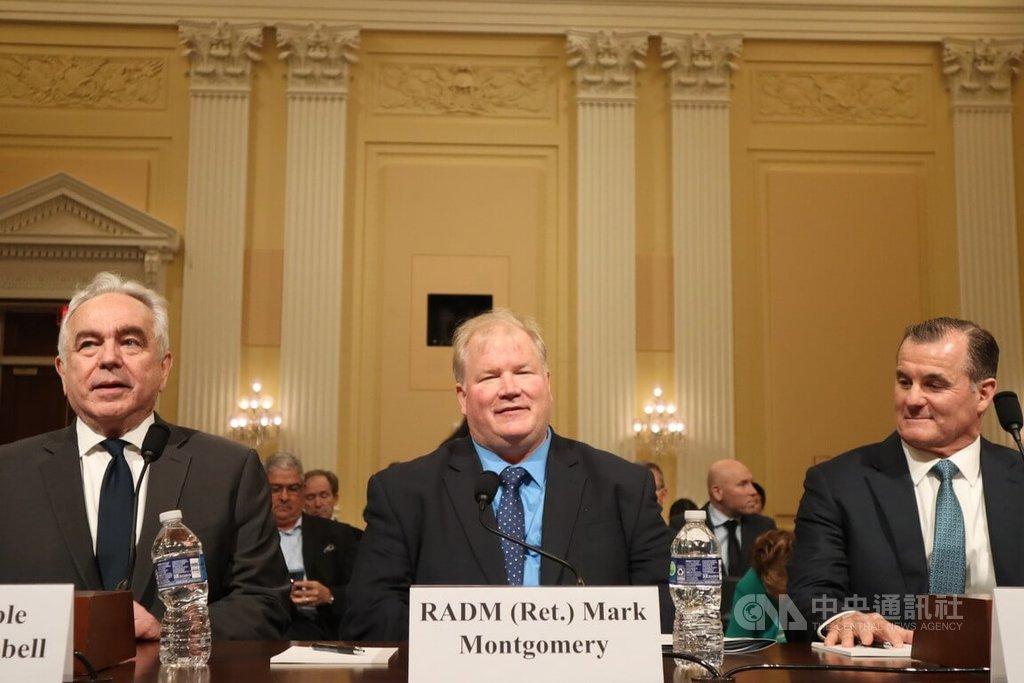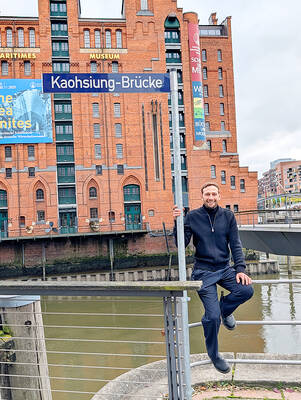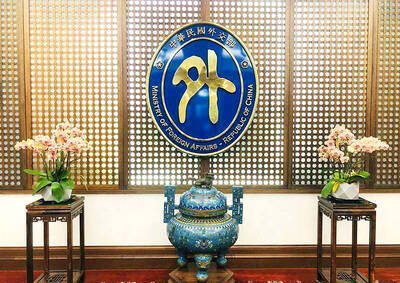Three former US military and political leaders yesterday recommended that Taiwan reasonably increase its defense budget, and the US military increase its training in Taiwan and forces in the Indo-Pacific region to deter Chinese aggression.
The US House Select Committee on Strategic Competition between the US and the Chinese Communist Party held a hearing titled “Deterrence Amid Rising Tensions: Preventing CCP Aggression on Taiwan,” inviting retired US army general Charles Flynn, former deputy secretary of state Kurt Campbell and retired US navy rear admiral Mark Montgomery to give testimonies.
Montgomery said that the US joint training mission in Taiwan should be expanded from 500 to 1,000 personnel, and advocated that Taiwan’s defense budget should reach 5 percent of GDP by 2028.

Photo: CNA
The US has never formally announced the number of troops it has stationed in Taiwan.
The US Congress passed the Taiwan Enhanced Resilience Act in 2023, instructing the executive branch to train Taiwanese troops, but the Ministry of National Defense has been slow to make progress, Montgomery said.
Taiwan still needs the investment and participation of the US military to establish an effective deterrence force with appropriate combat capabilities, he said.
Flynn also emphasized the importance of US military training.
The US could provide Taiwan with 400 Harpoon missile systems, but it is useless if Taiwan does not have teams that know how to operate, deploy and manage these systems, Flynn said.
US military training would help Taiwanese troops understand how to implement defense in depth, which is “the key value we bring as a training unit,” he said.
President William Lai (賴清德) announced a special budget in February, with the goal of increasing defense spending to at least 3 percent of GDP.
US Representative Dusty Johnson said that there is no consensus within Taiwan’s divided government to reach this 3 percent goal, questioning whether Montgomery’s proposed 5 percent goal is feasible.
Montgomery said that by spending 5 percent of GDP on the military, Taiwan would be able to purchase all the systems it needs and establish real combat readiness.
Historically for democratic countries, 5 percent is an achievable standard, he said.
Having a military budget equal to 10 percent of GDP is unrealistic for Taiwan, as this would mean purchasing US$40 billion in Foreign Military Financing (FMF) equipment from the US every year, he said.
“I believe everyone is well aware that we currently cannot even provide US$350 million of FMF annually,” Montgomery said.
Unless the Foreign Military Sales system is completely transformed and its efficiency improved by 1,000 percent, Taiwan’s military budget would not be able to reach 10 percent of its GDP, he said.
Campbell, who left office in January, said that while it is crucial to focus on what Taiwan needs to do and how to support Taiwan, the US must continue to strengthen its own capabilities and shift more forces to the Indo-Pacific region.
“We are the ultimate backing force,” Campbell said.
It is in US interests to continue supporting Taiwan, Campbell said, highlighting the achievements Taiwan has made over the past four years in technology, politics and strategy with US backing.

The Executive Yuan yesterday announced that registration for a one-time universal NT$10,000 cash handout to help people in Taiwan survive US tariffs and inflation would start on Nov. 5, with payouts available as early as Nov. 12. Who is eligible for the handout? Registered Taiwanese nationals are eligible, including those born in Taiwan before April 30 next year with a birth certificate. Non-registered nationals with residence permits, foreign permanent residents and foreign spouses of Taiwanese citizens with residence permits also qualify for the handouts. For people who meet the eligibility requirements, but passed away between yesterday and April 30 next year, surviving family members

The German city of Hamburg on Oct. 14 named a bridge “Kaohsiung-Brucke” after the Taiwanese city of Kaohsiung. The footbridge, formerly known as F566, is to the east of the Speicherstadt, the world’s largest warehouse district, and connects the Dar-es-Salaam-Platz to the Brooktorpromenade near the Port of Hamburg on the Elbe River. Timo Fischer, a Free Democratic Party member of the Hamburg-Mitte District Assembly, in May last year proposed the name change with support from members of the Social Democratic Party and the Christian Democratic Union. Kaohsiung and Hamburg in 1999 inked a sister city agreement, but despite more than a quarter-century of

Taiwanese officials are courting podcasters and influencers aligned with US President Donald Trump as they grow more worried the US leader could undermine Taiwanese interests in talks with China, people familiar with the matter said. Trump has said Taiwan would likely be on the agenda when he is expected to meet Chinese President Xi Jinping (習近平) next week in a bid to resolve persistent trade tensions. China has asked the White House to officially declare it “opposes” Taiwanese independence, Bloomberg reported last month, a concession that would mark a major diplomatic win for Beijing. President William Lai (賴清德) and his top officials

The Ministry of Foreign Affairs (MOFA) yesterday expressed “grave concerns” after Singaporean Prime Minister Lawrence Wong (黃循財) reiterated the city-state’s opposition to “Taiwanese independence” during a meeting with Chinese Premier Li Qiang (李強). In Singapore on Saturday, Wong and Li discussed cross-strait developments, the Singaporean Ministry of Foreign Affairs said in a statement. “Prime Minister Wong reiterated that Singapore has a clear and consistent ‘one China’ policy and is opposed to Taiwan independence,” it said. MOFA responded that it is an objective fact and a common understanding shared by many that the Republic of China (ROC) is an independent, sovereign nation, with world-leading